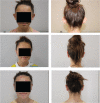Otoplasty: a modified Chong-Chet technique with positive long-term results
- PMID: 34678892
- PMCID: PMC8542138
- DOI: 10.1097/MD.0000000000027554
Otoplasty: a modified Chong-Chet technique with positive long-term results
Abstract
Background: In the last few decades, many techniques have been developed to correct prominent ear deformities. Modified Chong-Chet otoplasty represents a new and improved classical Chong-Chet procedure for prominent ear surgery. This study evaluates and compares the long-term results of standard Chong-Chet otoplasty with the modified technique.
Methods: A retrospective study was conducted on patients undergoing otoplasty at the Special Hospital S-tetik Banja Luka between January 17, 2017, and February 5, 2019. The total number of patients undergoing the procedure was 129. The first group (48 patients) underwent otoplasty using the Chong-Chet technique, while the second group (81 patients) underwent a modified Chong-Chet procedure. All patients were randomly selected on the condition that the antihelix was absent.The data were processed and analyzed using the Statistical Package for the Social Sciences version 24 using nonparametric tests (χ2 test, Mann-Whitney U test and Kruskal-Wallis test).
Results: Every second patient was satisfied (19 patients were partially satisfied and five patients were completely satisfied) with the results of the classical Chong-Chet technique. Seven patients were neither satisfied nor dissatisfied, while 17 patients were dissatisfied (11 patients were completely dissatisfied and 6 patients were mostly dissatisfied). As for the modified method, on average, nine out of 10 patients (73 or 90.1%) were satisfied, of which 49 patients (60.5%) were completely satisfied and 24 patients (29.6%) were mostly satisfied.The statistical significance was P < .05.Research results point to the modified Chong-Chet technique being a significant improvement to the classical method.
Conclusion: Modified Chong-Chet technique increases the number of positive long-term results and significantly improves the standard method.
Copyright © 2021 the Author(s). Published by Wolters Kluwer Health, Inc.
Conflict of interest statement
The authors have no conflicts of interest to disclose.
Figures






References
-
- Johnson PE. Otoplasty: shaping the antihelix. Aesthetic Plast Surg 1994;18:71–4. - PubMed
-
- Ersen B. A modification of the posterior perichondrio-adipo-dermal flap for protruding ear correction: a customized technique. Ann Plast Surg 2019;83:500–6. - PubMed
-
- Sands BN, Adamson PA. Pediatric esthetic otoplasty. Facial Plast Surg North Am 2014;22:611–21. - PubMed
-
- Mazeed AS, Blustrode NW. Refinements in otoplasty surgery: experience of 200 consecutive cases using cartilage-sparing technique. Plast Reconstr Surg 2019;144:72–80. - PubMed
-
- Schneider LA, Sidle MD. Cosmetic otoplasty. Facial Plast Surg Clin North Am 2018;26:19–29. - PubMed
Publication types
MeSH terms
LinkOut - more resources
Full Text Sources
Medical
Research Materials

